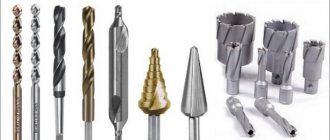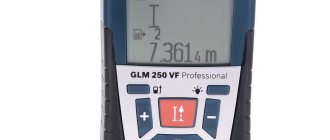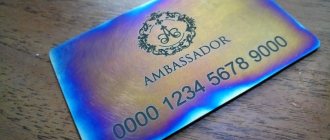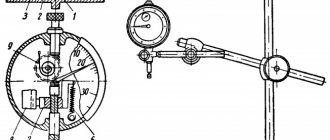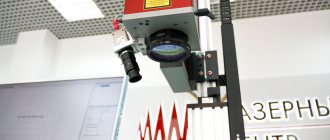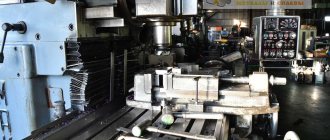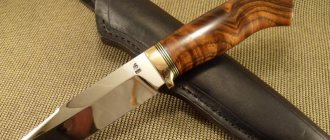Updated: 04/23/2021 15:30:07
Expert: Konstantin Borisovich Polyakov
*Review of the best according to the editors of expertology.ru. About the selection criteria. This material is subjective in nature, does not constitute advertising and does not serve as a purchase guide. Before purchasing, consultation with a specialist is required.
Laser rangefinders are extremely popular among domestic consumers. Some buyers use the electronic device during repairs and construction, others use it on vacation, and the device is also used by the military. For different purposes, models will differ significantly in both their technical parameters and functionality. Accordingly, there is a large discrepancy in price. To avoid wasting your money, experts recommend paying attention to several points.
Criteria for choosing a laser rangefinder
- First of all, it is worth deciding on the working measurement range
. Internal work can be carried out with a device with a maximum measuring range of up to 40-50 m. In this case, the minimum measuring distance becomes an important characteristic. - The error of
the measuring device depends on the measuring range. The higher it is, the lower the accuracy becomes. Only professional models keep the error at 1-2 mm. - For work in the construction industry or when used outdoors, the longevity of the rangefinder will depend on the sealing of the housing
. It is better to give preference to electronic devices with a security level of more than 54 IP. - A tripod will be a useful option when working with a rangefinder for a long time. Some models come with this accessory, while other manufacturers make a special connector for connecting to a tripod.
- The functional content
depends on the purpose of the device. Repairs in an apartment can be carried out with a simple device, where there is only a calculator. But serious hunters choose laser models that can determine the distance to a moving object and then calculate the trajectory of the bullet. Builders value models that can calculate area, volume, angles of inclination, etc.
Our review includes the best laser rangefinders. When selecting applicants, the following criteria were taken into account:
- purpose of the device;
- technical specifications;
- price;
- expert opinion;
- consumer reviews.
Additional features of rangefinders
In addition to standard functions, the rangefinder may have additional capabilities.
Their relevance depends on the tasks you set. A variety of functions are built into modern laser rangefinders: calculating area and volume, performing arithmetic operations with subsequent storage, optical and digital sights. Most useful: Level
. Indispensable if you need to determine the correspondence of surfaces to vertical or horizontal planes, as well as for measuring deviations. By choosing a laser rangefinder with a level and an inclinometer, you can not only replace several devices with one, but also perform all measurements simultaneously.
Protection from moisture and dust
. A laser rangefinder is a precision electronic device for which any exposure to water or dust can be fatal. Typically, all models are made dustproof and resistant to moisture. We recommend purchasing models with increased protection if operating conditions require it. It is also better to purchase an additional protective case for safe transportation and storage.
Display and keyboard backlight
. Even the most expensive models with a bunch of functions sometimes have a simple monochrome display and regular keys. In some cases, especially during daytime street work, this will cause a lot of inconvenience.
Bluetooth
with connection to a tablet, laptop or smartphone. Thus, all received data can be quickly and conveniently analyzed, saved and transferred to third-party programs. Otherwise, you will have to enter all the received data manually, which will noticeably slow down the pace and speed of work.
Rating of the best rangefinders
| Nomination | Place | Name | Price |
| The best rangefinders for home | 1 | Makita LD080PI | 10 910 ₽ |
| 2 | LEICA DISTO D2 NEW | 12 792 ₽ | |
| 3 | BOSCH GLM 500 | 5 209 ₽ | |
| 4 | Makita LD030P | 4 740 ₽ | |
| 5 | Xiaomi Duka LS-P Laser Range Finder | 1 520 ₽ | |
| The best professional laser rangefinders | 1 | Leica Disto D510 | 17 113 ₽ |
| 2 | BOSCH GLM 250VF | 25 146 ₽ | |
| 3 | Stabila LD 520 | 36 880 ₽ | |
| 4 | BOSCH GLM 120 C | 17 059 ₽ | |
| 5 | Leica DISTO X310 | 19 850 ₽ | |
| 6 | FLUKE 424D | 16 670 ₽ | |
| 7 | Control XP4 Pro | 13 000 ₽ | |
| 8 | BOSCH GLM 80 + R 60 Professional | 14 290 ₽ | |
| The best rangefinders for outdoor activities | 1 | Nikko Stirling NSLRF603 distance 15-1200 m | 18 890 ₽ |
| 2 | ADA Shooter 400 | 7 196 ₽ |
What to pay attention to
Not all features are equally important to hunters—some are promoted by rangefinder manufacturers for promotional purposes or are important in other areas. For example, for a high-altitude installer, it is important to determine the distance between posts with an accuracy of half a meter, but for a hunter, most often an error within 5 meters is acceptable.
Here's what to look for when purchasing first:
- Measuring range
The range of a shot on a hunt rarely exceeds 300 meters, so for most hunters even the simplest and cheapest models of rangefinders, the measurement threshold of which is up to 500 meters, are suitable. However, with the proliferation of expensive high-precision rifles and digital sights (including thermal imaging) with high magnification, a confident shot can be made at distances of about 1000 meters! For such powerful lasers, not only the range is important, but also the size of the light spot at this distance - see point 3.
- Measurement accuracy
Accuracy is an important parameter of a measuring instrument. Most laser rangefinders have no problems with this. Several entry-level models have an accuracy of 5 meters per kilometer, but the rest determine distances with an accuracy of less than a meter. This level of accuracy is enough to calculate and make corrections for bullet drop.
- Divergence
There are no ideal lasers. The light spot of the optical emitter increases slightly at a distance. This phenomenon is called divergence. The amount of beam divergence can be measured in degrees, meters or other units, but in artillery it is common to use thousandths of a radian or simply “thousandths”. The fact is that a deviation of “one thousandth” at a distance of a kilometer is about a meter. Very convenient for mental counting.
The laser divergence is relatively small and ranges from fractions to several milliradians. To make it clear, a value of 0.5 mrad means that the light spot at a distance of 100 meters has a size of 5 cm. This is a very important parameter when taking into account the dimensions of a distant target, for example, a wild boar, bear or deer.
- Lens magnification
The optics of hunting rangefinders usually have a magnification of 6x - 8x. This is quite enough to observe the animal and determine the distance within a kilometer. Stronger magnifications are used only in military models or special-purpose devices that weigh tens of kilograms.
- Lens diameter
The larger the lens size, the higher the aperture ratio, and therefore the ability to observe the target in low light. Popular models of laser rangefinders for hunting have optics Ø 20-30 mm. A diameter that is too large is also not good, because the device loses its compactness and becomes heavier.
It is worth noting here that in most rangefinders the combination of magnification and lens diameter gives a small viewing angle and aperture ratio. Even at dusk, the LCD display information merges with dark objects. If you plan to conduct observations and measurements late in the evening, then it makes sense to buy a rangefinder with a backlit display function, and if at night, then it makes sense to choose rangefinders with a night vision function.
- Weight and dimensions
Unlike military ones, laser rangefinders for hunting weigh no more than 400 grams, are small in size and easily fit in a jacket pocket. You need to choose an ultra-compact model when you save every gram, for example, in the mountains.
- Battery life
Manufacturers guarantee continuous operation time without replacing batteries of 8 - 10 hours. In reality it turns out more. The fact is that energy is spent mainly by the laser, and it is not turned on often. In severe cold, the battery capacity decreases, so it is better to keep the device warm, in an internal pocket. A spare power source for hunting won’t hurt either.
The best rangefinders for home
Simple and affordable devices can successfully play the role of home rangefinders. With their help you can make repairs and arrange furniture. The models are not distinguished by outstanding technical capabilities and rich functionality. Experts paid attention to the following models.
Makita LD080PI
Rating: 4.7
The Japanese laser rangefinder is one of the highest quality among household ones. It is capable of measuring distances up to 80 m, adding and subtracting values, calculating the area of an object and determining height. The origin can be selected using three points. The home laser device is distinguished by its high accuracy of 1.5 mm, and also has a memory of 20 cells. This is convenient for saving the latest results and quickly recalling them if you forget to write down the data - you don’t have to measure the room again. The laser device runs on two batteries, which are already included in the kit. A case and positioning bracket are also provided. The user has access to a key lock and a timer that protects against self-discharge during inactivity. Reviews show that the laser device is easy to set up thanks to the pictures on the buttons rather than the inscriptions in English.
Owners like the rangefinder due to its convenient form factor. Due to two concave sides, it fits comfortably in the hand and cannot be dropped even during active actions. The flat buttons are flush with the bezel and are easy to press with one thumb. We recommend a laser model if there is a lot of work to be done - it will be very convenient to take measurements with it, especially with the continuous measurement function.
Advantages
- informative pictures on buttons;
- batteries included;
- ergonomic form factor;
- high accuracy 1.5 mm.
Flaws
- memory for only 20 values.
Budget products
3. PRACTICE DL-20 (247-170)
The maximum distance that can be measured with this device is 20 meters. Based on the information received, the device automatically calculates the perimeter, area, volume of the room and other indicators. Despite its rather compact size, this equipment is equipped with a decent digital display of large dimensions. The numbers displayed on it are quite large, they will be clearly visible even to a person with poor eyesight. Despite the fact that the device belongs to a cheap price category, it is equipped with fairly high quality optics. This allows you to achieve high data accuracy; the equipment error is only 1 mm.
Most owners of this product claim that the measurement accuracy is indeed very high. The display has LED backlighting, which allows you to work with this product even in complete darkness. When inactive, the equipment turns off automatically. The rangefinder has a rubberized body that perfectly protects not only from the penetration of dust and dirt, but also from strong impacts. The most common AA batteries serve as power supply elements, and they last for quite a long time.
More: TOP 10 thermostats for heated floors
Advantages:
- Low cost;
- High efficiency indoors;
- Long period of operation;
- The batteries alone last for approximately 14 hours of continuous operation;
- Reliable protection from water, dust and dirt, as well as from physical influences.
Flaws:
- The batteries are discharged even when the device is turned off.
Laser rangefinder PRACTICE DL-20 (247-170)
2. INSTRUMAX SNIPER 30
A simple and fairly budget model that will be well within the means of most of our readers, it has all the necessary functions for home use. The appearance of the device is quite simple, but it has a certain elegance and attractiveness. The rangefinder has a primarily black color scheme, but the front panel is painted blue. The power button contrasts as it is made red. The shape is rectangular, somewhat elongated, with some narrowing observed towards the bottom of the structure. Thanks to this feature, the device is very comfortable to hold in your hands and will not slip out. The buttons are large, have a medium stroke, and are easy to hit, so this device can be operated even with gloves.
The cost of the unit is low, there are no rubber pads to increase resistance, there is some ribbing on the sides that does not allow the device to slide. On the surface of the case there is a special hole for a hand strap. On the top edge there is a window that emits a laser beam and a receiver that provides a response to its return. The rear panel has a compartment for installing power supplies. It is closed with a plastic lid. The device runs on two batteries or pinky batteries. The display is quite simple, liquid crystal, has two lines, the bottom one is slightly larger than the top one, the screen has LED backlighting. In addition to basic measurement data, it has a reference point icon and a battery charge indicator. After two minutes of inactivity, the unit turns off.
Advantages:
- Small overall dimensions;
- The device fits easily in the hand;
- High measurement accuracy;
- The maximum range is higher than that stated by the manufacturer.
Flaws:
- The body is made entirely of plastic, which makes it a little slippery, especially if you hold the device with gloves.
Laser rangefinder INSTRUMAX SNIPER 30
SNDWAY SW-M40
The product design is standard for budget laser rangefinders. Despite the fact that the equipment is not too expensive, the build quality is at a professionally high level, all elements of the case are carefully calibrated and adjusted to each other. There are no gaps, defects or backlashes. The unit runs on two AA batteries; the compartment for them is tightly closed with a plastic lid. The protection class against dust, dirt and water is IP54, which indicates a sufficiently high protection of the device from the penetration of debris and moisture. The keyboard includes seven keys at once, which are located at a fairly significant distance from each other. This allows you to use this device even with thick gloves. The movement of the buttons ends with a characteristic click, indicating that the press has been completed. The buttons are quite soft.
The design includes a bubble level, and the movement of the air bubble is quite smooth. This design will not replace a professional level, but in certain situations it is better than nothing. The overall dimensions are small: they are 112x50x25 mm. The device calculates indicators almost in real time, the delay is insignificant and is only a few tenths of a second. Before direct use, the device will have to be calibrated. How to do this correctly is described in detail in the instructions.
Advantages:
- Low cost;
- Wide functionality;
- Instant calculation of measurements;
- There is a built-in level;
- Large display on which you can easily view all the necessary information;
- Small overall dimensions.
Flaws:
- Soft buttons that can be pressed through after several years of use.
Laser rangefinder SNDWAY SW-M40
The best professional laser rangefinders
Professional builders place the highest demands on the technical parameters and functionality of rangefinders. For them, range, accuracy, and the ability to perform serious mathematical calculations are important. The following models became the best.
Leica Disto D510
Rating: 4.9
The most important advantages of the Leica Disto D510 laser rangefinder over its competitors are its power and rich functional equipment. Just look at Bluetooth Smart; thanks to this option, you can analyze measurement results on your mobile phone or tablet. The device can work with applications for IOS and Android operating systems. As for technical capabilities, experts note a long measurement range (200 m), high accuracy (1 mm), and low weight (198 g).
The winner of the rating has a full set of additional functions. This includes a color display backlight, a shock-resistant case, an angle calculation function, Bluetooth, a marking mode, and the ability to mount on a tripod.
Advantages
- full set of functions;
- light weight;
- reliability and durability;
- good technical characteristics;
Flaws
- high price.
Principle of operation
Pulse . The operating principle is based on a constant speed of light. Knowing the travel time, the distance to the desired object is calculated. The light flux is supplied in short pulses.
They have great power and are used to measure large distances - from a kilometer to cosmic scales.
Phase . The work is based on the property of the light flux to change the modulation phase (in simplified terms - vibration parameters) when reflected from an object. The distance is calculated by the processor based on a number of measurements.
The measurement accuracy is ±0.5 mm, which is comparable to the magnitude of a low-frequency light wave. They have low power, the measurement range does not exceed 1 km. The devices are quite cheap. The main direction is application in household devices.
Types of devices:
- household rangefinder;
- rangefinder binoculars;
- hunting device;
- device for the machine;
- construction level with laser sight;
- monocular rangefinder;
- inexpensive laser rangefinder;
- rangefinder-roulette;
- rangefinder with protractor.
The best rangefinders for outdoor activities
Laser rangefinders have also found application in active recreation. Some determine the distance from a sporting point of view, others determine the optimal moment for an accurate shot at the animal. Two functional models were included in the rating.
Nikko Stirling NSLRF603 distance 15-1200 m
Rating: 4.9
The outdoor rangefinder operates with an eye-safe 905 nm laser beam (wavelength) so you can view through the eyepiece continuously. If more precise targeting is required, an electronic image magnification of 6 times is provided. The maximum distance determination range is 1200 m. Minimum measurements can be taken from 15 m. The laser device is powered by a 3V CR2 battery, the charge of which is enough for 5000 measurements. If the device is not used for 10 seconds, it turns off automatically. The dust- and moisture-proof housing is practical for fishing, hunting and tourism. The rubberized coating with pimples provides a secure grip. The digital rangefinder has built-in automatic flag detection function, which is practical for military purposes on land and sea. The aiming reticle makes it easier to target an object.
Tourists and hunters like the rangefinder due to its high measurement speed. All calculations (travel of the laser beam 1.2 km in one direction, return and calculations) take less than 1 second. The laser monocle also has a low error of 1 m. You can aim at an animal while being 1 km away from it and not make a mistake in calculating corrections for the wind.
Advantages
- anti-slip pads on the body;
- loops for hanging on a cord;
- measuring range 1200 m;
- You can enlarge the image up to 6 times.
Flaws
- large dimensions 106x73x41 mm.
How does a rangefinder work?
The speed of light in a vacuum is a fundamental physical constant. It is approximately equal to 300 thousand km/sec. Modern electronics can accurately measure the time it takes for a light beam to reach a target, reflect, return, and calculate the distance. This is how a laser rangefinder works, without going into technical details.
Depending on temperature, humidity and air pressure, the speed of light may differ from the calculated constant. To achieve the required accuracy, the rangefinder does not just measure time, but takes into account all these parameters, making corrections.
Sight with rangefinder
The most convenient for hunters are sights with a rangefinder. This is especially true for hunting from the approach, where it is necessary to track the animal, tens of kilometers through the forest, carrying all the equipment. Optical sights with a rangefinder are available only among premium brands: Carl Zeiss, Burris, Swarovski, Steiner and their cost starts from 300,000 rubles.
But in this budget, it would be more advisable to choose a digital or thermal imaging sight with a rangefinder. Such scopes allow you to hunt both during the day and at night. And this is especially convenient, because you don’t have to change and adjust day and night sights. Using a thermal imaging scope is much easier to determine the trophy value of an animal, and a rangefinder will be a good assistant in this. Read more about digital sights in this article.
The disadvantages of sights with a rangefinder include their high cost and specific purpose: using such a device without a weapon will be at least strange. However, the viewing angle of sights is inferior to the viewing angle of binoculars or monoculars.
Distance to target 100 meters (in the lower left corner) Visible image of the Pylcap Dіgіѕіght Ultra N455 LRF sight with rangefinder
Ballistic calculator
The shooter needs a laser rangefinder to calculate the ballistic correction. Knowing the exact distance to the target, you can do this yourself. But a more modern and accurate method is to use the built-in calculator, which is found in many instrument models. Leica presents a wide range of rangefinders with a ballistic calculator on the Russian market.
| Distance to target 935 meters | Distance to target 55 meters |
In addition to the standard vertical correction, which is automatically calculated by the ballistic computer in arc minutes and sight clicks, some devices have a built-in protractor. The hunter can take into account adjustments to a target located above or below the horizon of the weapon - the so-called elevation adjustment.
If the rangefinder has a mode for measuring target speed, the electronics will help not only calculate the horizontal correction, but also choose the correct lead.


